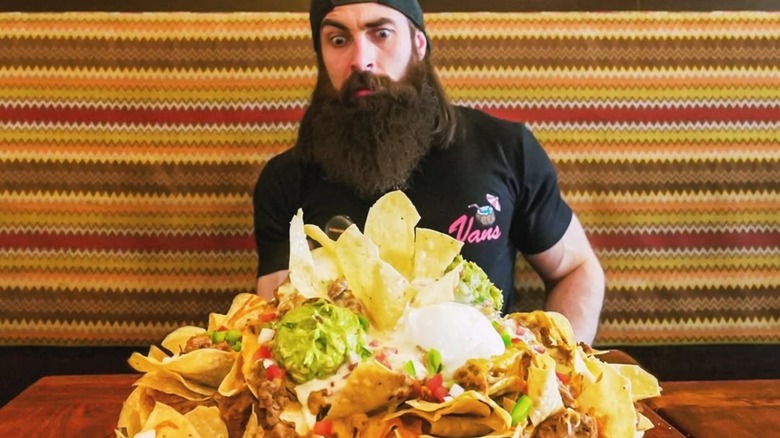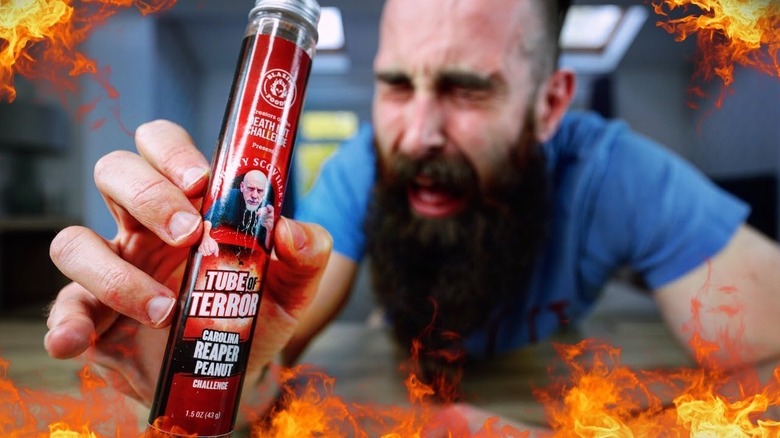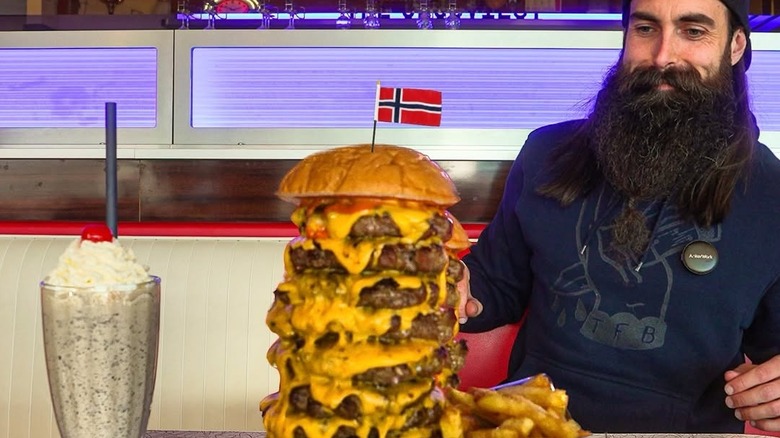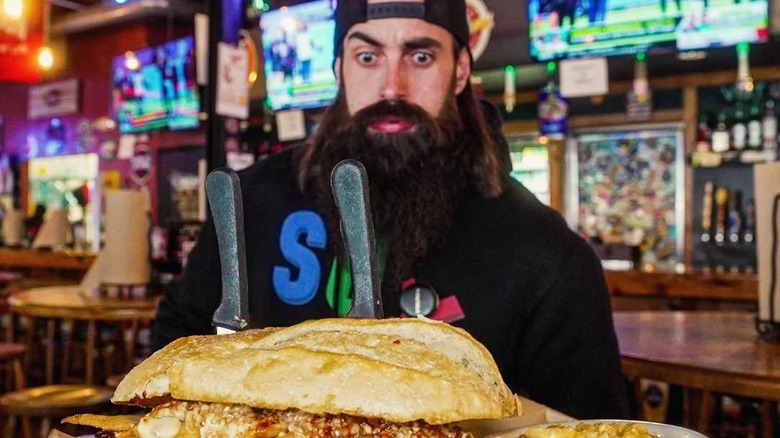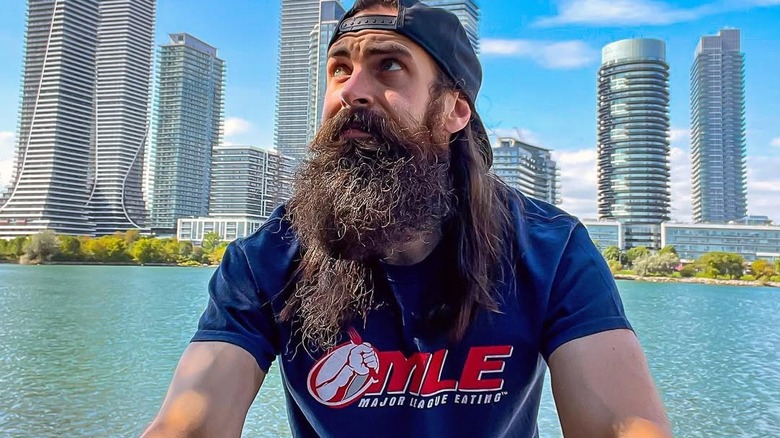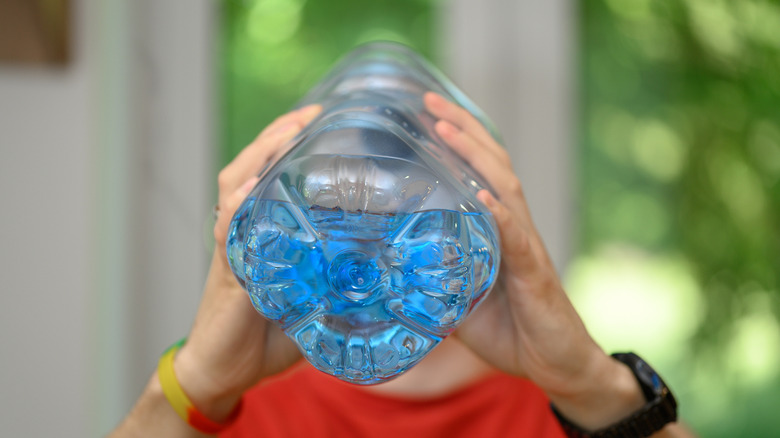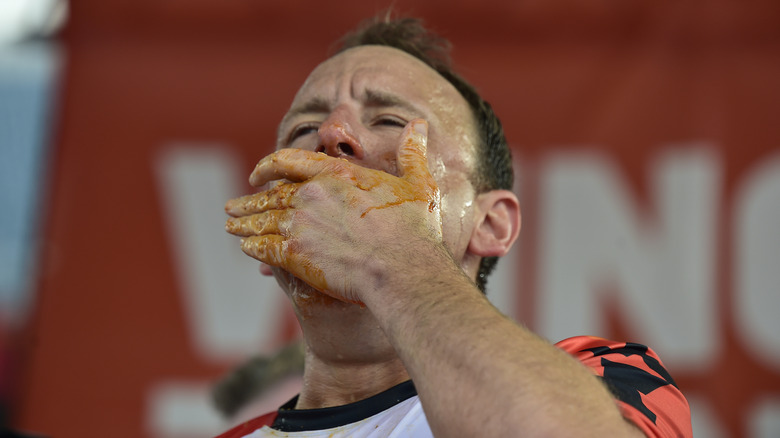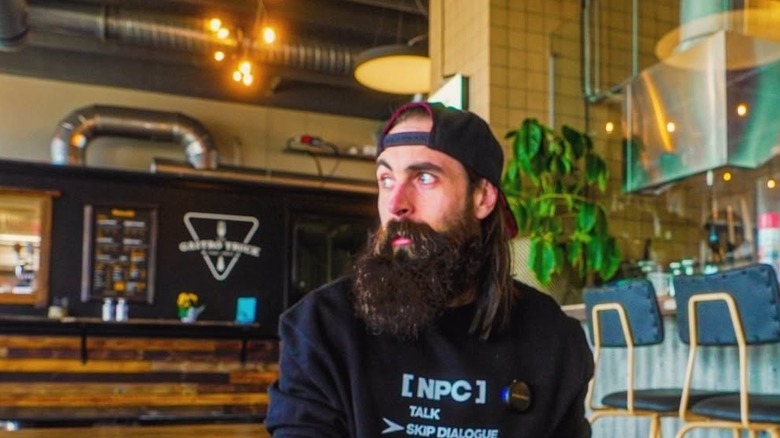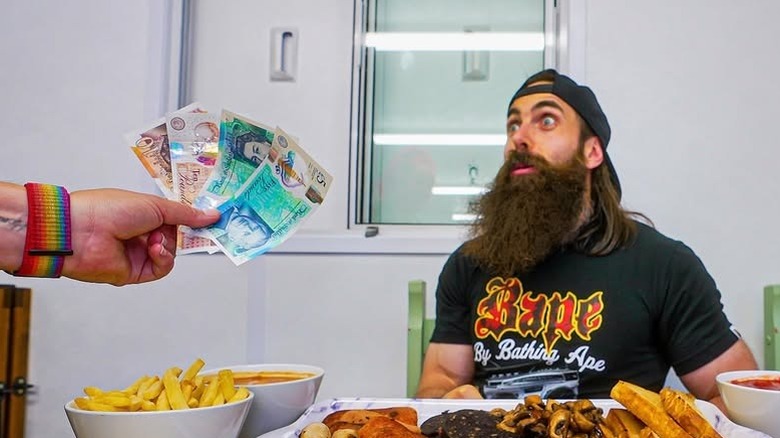The Struggles Of Adam Moran's Beard Meats Food Career
The speed-eating world is competitive. Every year, people from the U.S. to Europe to Japan to Australia attend speed-eating challenges in a bid to prove that they can scarf down the most food in the shortest time. And some of them are so good that they become professionals. Take Joey Chestnut, for example. The Indiana eater has a reported net worth of around $3 million and holds dozens of speed-eating titles, including the world record for hot dog eating. Currently Chestnut is ranked number one in the world by Major League Eating, the organization responsible for overseeing competitive eating events. But plenty of people are coming for Chestnut's crown, and among them is the U.K.'s number one speed eater, Adam Moran.
Moran — who is also known as "Beard" due to his speed-eating YouTube account Beard Meats Food — is world number 22 in the speed-eating ranks. But he is on a mission to get better and better. Every week, he posts new videos to his more than 4.9 million subscribers that show him taking on bigger and better eating challenges, both in the U.K. and in the U.S.
But the life of a speed-eater is not easy. If he wants to rise up in the Major League Eating ranks, Moran has to deal with everything from social media trolling over his relationships to serious health risks and injuries as a result of his sport. Keep reading to find out more about the biggest struggles of Moran's career so far.
He went through a public relationship split
When you build a career on social media, it's hard to keep your private life out of the public eye. This was the case with Adam Moran, who regularly showed his partner Lindsay Wood in his YouTube videos. Often, Wood would either be on camera or you could hear her speaking with Moran from behind the lens as he took on various extreme eating challenges.
However, Wood's involvement with Moran's social media platform meant that when they split after 12 years together in 2023, lots of people had opinions. Both Moran and Wood had to deal with many negative comments from viewers. This was despite the fact that both confirmed that there was no animosity involved in the decision to go their separate ways, and that they had naturally decided to take different paths. In an Instagram statement, Wood confirmed that she would remain friends with Moran. "[We] both just want different things in life," she wrote.
But in the end, trolls are going to troll. Some fans chose to make negative comments about the relationship, even choosing to comment on Wood's appearance. To this day, more than a year after the split, Wood, in particular, is still receiving negative comments on her Instagram about the end of her relationship with Moran. However, she has responded saying she is happy as she is. Both Moran and Wood, however, appear to have moved on from the split and are dating other people.
His eating challenges can leave him in severe discomfort
It's perhaps no surprise that speed-eating can cause discomfort. Even for the average person, gobbling down a meal too quickly can lead to indigestion, which includes unpleasant symptoms like abdominal pain, gas, nausea, heartburn, and bloating. As a professional speed-eater, Adam Moran is likely used to this discomfort. However, that doesn't mean he doesn't have trouble with this now and again.
Five years ago, for example, Moran ate super spicy peanuts for a YouTube video. And by super spicy, we mean really, really spicy — like 13 million units on the Scoville scale spicy. For context, the hottest pepper in the world, Pepper X, has a Scoville score of more than 2.6 million units.
The rules of this particular challenge — which involved eating Johnny Scoville's Tube of Terror peanuts, which are coated in crystals of capsaicin — were that he had to finish the whole tube within 10 minutes, and then sit for five minutes without seeking relief. As soon as he started to eat the nuts, he looked visibly uncomfortable. He began to hiccup, struggle to speak, and sweat. By the end of the tube, he looked in visible pain as he shook and salivated. He even told Lindsay Wood, who was talking to him off camera, that he couldn't feel his fingers, and repeated that he was scared. Moran ended up asking for milk before the final five minutes was up. "Just drink," said Wood. "I can't watch you in pain."
The speed eating contests he takes part in present a dangerous choking risk
At the end of the spicy peanut challenge, Adam Moran told Lindsay Wood that he'd done some "crazy stuff" throughout his eating career, even once nearly choking to death. This is a serious risk for anyone who takes part in competitive eating challenges, as they require people to continuously fill their mouths with food under the pressure of a time limit. This can result in the food blocking the airways, which stops any oxygen from getting through. This can lead to brain damage or death if not resolved quickly.
Sadly, there have been many incidents where people have died as a result of choking during speed-eating competitions. In November 2016, one man, who was taking part in a competitive eating challenge in Japan, attempted to eat five onigiri balls in three minutes, but ended up choking during the competition. He fell unconscious as a result, and later died. Two years prior to this incident, another man began choking in the U.S. while taking part in a hotdog eating competition for the Fourth of July. Paramedics attempted to remove the blockage in his throat, but their attempts were ultimately unsuccessful and the man later died in hospital.
In 2023, a 37-year-old mom in Wales died from choking during a marshmallow eating competition. And in 2017, a 20-year-old college student from New Jersey died as a result of choking after a pancake contest.
Most of the challenges he takes part in revolve around unhealthy foods
Choking is far from the only health risk associated with speed eating. Professionals like Adam Moran, who regularly take part in challenges to make money, often have to eat huge amounts of unhealthy foods in order to win the prize. Often, he is filmed in front of huge plates of processed meats and salty, fatty foods, like burgers, onion rings, and fries, for example.
Most experts agree that, for the average person, there is nothing wrong with eating these types of foods in moderation. But competitive eaters, of course, do not do moderation. In 2016, Moran set a World Record for the most McDonald's McNuggets eaten for a YouTube video, for example, which involved him having to eat 155 chicken nuggets in 150 minutes. The year before that, he set another record for the most McDonald's Big Mac burgers eaten in one hour.
Research suggests that fast food is high in sodium, sugar, and saturated fat. Because of this, eating it frequently can increase the risk of heart disease, stroke, and type 2 diabetes. On top of this, excessive consumption is also associated with a high risk of depression, high blood pressure, dental problems, and acne. Moran is aware of the risks that come with his job. He recently joked on Instagram that after 10 years, he has managed "to avoid that oft predicted heart attack." He added: "If you stick around, maybe I'll make it to twenty years."
Speed eating could be increasing his risk of chronic stomach problems
It's not just the types of foods that Adam Moran eats that could increase his risk of chronic health problems, but also the act of frequently eating lots of food extremely quickly. Research is limited into the sport (yes, speed-eating qualifies as a sport), but experts are concerned that it could cause competitors long-term issues with their stomachs.
If you've ever eaten a big meal on say, Thanksgiving, Christmas, or a summer barbecue, then you'll know that our stomachs do have the ability to stretch considerably. Usually, after the food has been digested, they will retract again. There is research to suggest that the stomachs of competitive eaters can expand more than the average person to accommodate the excessive amounts of food needed to win the competition, but this isn't without serious risk.
Due to the repetitive strain on their stomachs, competitive eaters like Moran could be at risk of conditions like gastroparesis, which is essentially stomach paralysis. People with gastroparesis face a life of discomfort while digesting food, as well as malnutrition, and even bezoars, which are hard lumps of undigested food that remain in the stomach. On top of this, they could be at a higher risk of intractable vomiting, which involves persistent vomiting that is hard to control.
He is required to fast around challenges, which can be uncomfortable
There are a few important lifestyle habits that Adam Moran has had to adopt to compensate for the risks that come with his chosen career. He regularly works out, for example. In fact, he usually heads to the gym each day for two hour sessions. He also says that when he's not taking part in challenges, he tries to be as healthy as possible with his food choices, opting for light options like yogurt, protein shakes, fruit, and cauliflower rice.
In the days around challenges, Moran also has to fast, which can be uncomfortable — especially considering his stomach has been stretched for challenges and is used to accommodating more food. He told The Independent that managing his diet in his career is a "discipline." He added: "You know you can't eat that much every day, because if you do, you'll get fat and probably die."
Cycles of binging and restricting, however, can also place stress on the body. Research into the specific long-term impact on competitive eaters is limited, but separate research into dieting and eating disorders suggests that the cycle may lead to negative impacts on metabolic rate and hormone levels.
If you need help with an eating disorder, or know someone who does, help is available. Visit the National Eating Disorders Association website or contact NEDA's Live Helpline at 1-800-931-2237. You can also receive 24/7 Crisis Support via text (send NEDA to 741-741).
He's aware that the water loading needed for speed eating is dangerous
The risks for competitive eaters don't just come from the food they consume during challenges and training, but also the water. Some competitors try to stretch their stomachs by water loading, for example, which basically involves drinking gallons of water in one go. But while staying hydrated is important for health, drinking too much in one go can actually be dangerous, and even fatal. This is because drinking too much water without clearing it out by sweating or peeing can lead brain cells to swell, which increases pressure.
Adam Moran tries to keep his water loading to a minimum, but he told The Independent he still drinks around 4 liters in a minute prior to a challenge. Research suggests this is still a potentially dangerous intake. For some people, water intoxication can kick in after consuming more than 3 liters in the space of a few hours, for example.
Some experts have also expressed that competitors may not be able to consume enough water during challenges, especially ones that involve eating a lot of salty fast food in a very short amount of time. This is because eating excessive amounts of salt can lead to dehydration, which comes with its own set of unpleasant symptoms, including dizziness and lightheadedness. "My concern is, if your stomach is so full of food, how are you going to get the other compensatory liquids in?" Rajeev Jain, MD, said to CBS News.
Like many competitive speed eaters, he is at a higher risk of painful jaw injuries and conditions
The risks of speed-eating don't end with water intoxication, dehydration, unhealthy foods, and potential lifelong stomach problems. No, speed eaters like Adam Moran also have to worry about their jaw health, too. This is because overuse of the jaw, through repeated chewing and widening of the mouth to fit in more food during competitions, can lead to painful conditions, including arthritis. This is a painful condition characterized by inflammation, and symptoms can include tenderness, stiffness, and weakness in the affected area. In fact, Debbie Petitpain, RDN, told CBS News that some competitive eaters have reported experiencing "excruciating pain" in their jaw as a result of arthritis.
Some competitors have also experienced lockjaw during competitions. In 2004, for example, now-retired professional eater Edward "Cookie" Jarvis experienced lockjaw in the middle of a sweet corn eating competition. Lockjaw, which is also sometimes caused by tetanus, can come with painful symptoms. Not only are they unable to open their jaw properly, but sufferers can also experience swelling, headaches, earaches, and muscle spasms.
Aside from lockjaw, other injuries associated with professional speed-eating include throat pain, swollen tongues (this is particularly problematic in spicy food challenges), stomach cramps, mouth cuts, and even pharyngeal abrasion, which is a painful sharp scratch in the back of the throat.
He has had to deal with soiling himself after challenges
Between the mess, the injuries, the risk of disease, and the huge piles of processed foods, there isn't much about speed-eating that is pretty. But it gets worse. After taking on a giant hot dog challenge (called Man vs Dog Challenge) at Holy Moly's Deep South Kitchen, a now-closed diner in York in the U.K., Adam Moran thought he was going to vomit. But instead, he pooped his pants. Unfortunately for him, he was filming for a TV show at the time, and the whole incident was caught on camera.
Moran isn't alone. Gastrointestinal discomfort and bowel problems are far from rare in the sport of speed-eating. The high amounts of sodium consumed in one go could lead to diarrhea, for example.
Vomiting is also common. In fact, being sick even has its own name in the speed-eating world. It's called a "reversal of fortune." If they vomit, a participant must swallow it back to keep going with the challenge. If the vomit touches the table, it's called a "Roman incident," and it may result in disqualification. It's likely called this because it was once thought that the Romans had specific places where they could throw up, called vomitoriums, which helped them purge their stomachs so they could eat more food. The theory has been debunked by experts, however.
He often has to deal with failure, which means he misses out on prize money
Competitive eaters like Adam Moran put their bodies through a huge amount of stress in order to win money. Some competitions pay thousands of dollars. Take Nathan's Hot Dog Eating Contest, for example. Winners of this world-famous contest, which takes place on the Fourth of July in New York every single year, can expect to take home around $10,000. Those who come in second place will receive $5,000, while third place receives $2,500, fourth gets $1,500, and the competitor in fifth place will receive $1,000.
But like with any sport, speed-eaters also have to deal with failure. This is something Moran has had to face on multiple occasions. On some occasions, he has failed the same challenge more than once. The first time he tackled The Huge BBQ Platter Challenge at Longhorns Barbecue Smokehouse in Newcastle in the U.K. for example, he left just one pot of beans on the plate after making is way through chicken wings, ribs, sausages, brisket, pork crackling, pulled pork, fries, buns, coleslaw, and jalapeños. He then went back to try the challenge for a second time, but once again, he couldn't finish the enormous plate of food.
Other challenges that Moran has failed include the Undefeated Bangers and Mash Challenge at a West Yorkshire pub called The Brown Cow; Birkenhead's Badass Burrito Challenge; and Hornsea Breakfast Club's 50 Item Fry Up Challenge.
